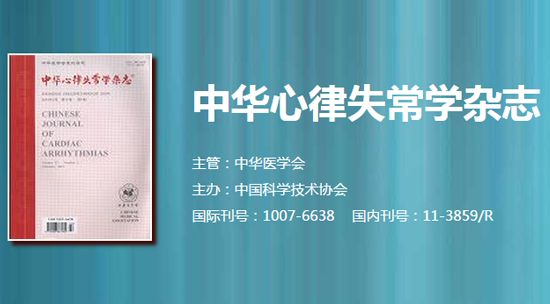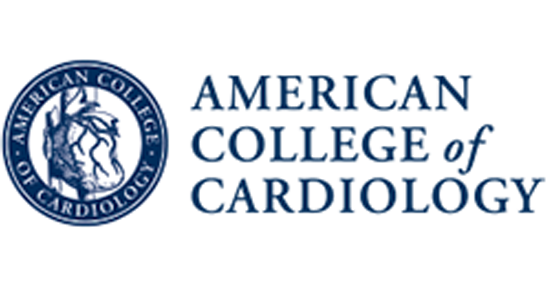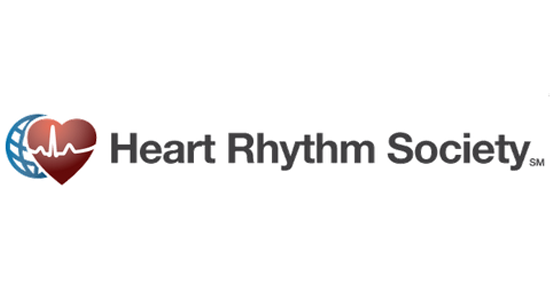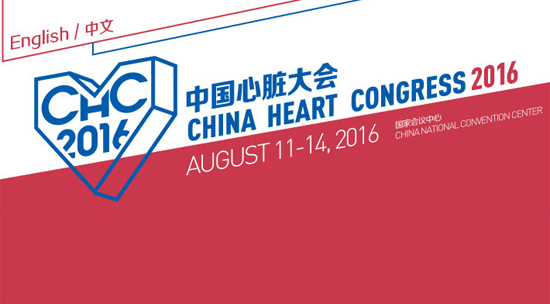HeartRhythm主编—陈鹏生教授语音速递(二月刊 英文版)
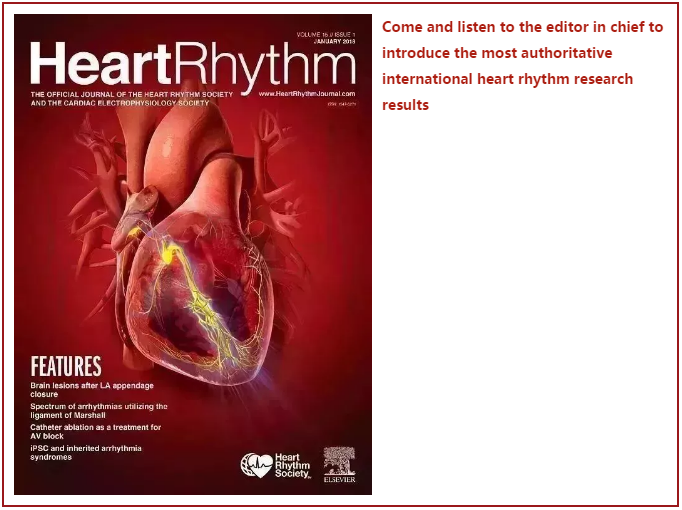

The first original article is titled “Right bundle branch block ventricular tachycardia in arrhythmogenic right ventricular cardiomyopathy more commonly originates from the right ventricle: Criteria for identifying chamber of origin”. The authors studied 110 consecutive patients with ARVC and VT who underwent VT mapping and ablation. They found 19 patients (17%) had 26 RBBB VTs. Among them, 11 (58%) had 16 RBBB VTs from the RV, and 9 patients (47%) had 10 RBBB VTs originating from the LV, with 1 patient demonstrating both. RBBB VT from RV most commonly had an early precordial QRS transition at V2 or V3, with superiorly and typically leftward directed frontal plane axis, whereas all 10 VTs from LV had RBBB morphology with positive R waves to V5 or V6 and rightward axis in 6 VTs characteristic of basal lateral origin. These findings show that precordial R-wave transition and frontal plane axis can be used to identify the anticipated chamber of origin of RBBB VT in patients with ARVC.
The next article is titled “Effects of 60-Hertz Notch Filtering on Local Abnormal Ventricular Activities”. The authors studied 110 local abnormal ventricular activities (LAVA) potentials recorded from 13 patients during VT ablation. Notch filtering significantly affected the LAVA morphology and reduced their amplitude. At least 2 high-frequency components were introduced into the LAVA by filtering at 33 sites. The area under continuous LAVA was reduced by 28%. The duration of continuous LAVA was reduced by 12%. The authors concluded that notch filtering can distort LAVA by reducing their amplitude, changing their morphology, and shortening their duration, leading to potential false positives and negatives. Mitigating the 60-Hz noise should focus on eliminating the source of noise, not applying notch filtering.
Up next is “Right Bundle Branch Block-type Wide QRS Complex Tachycardia with a Reversed R/S Complex in Lead V6: Development and Validation of Electrocardiographic Differentiation Criteria”. Differentiation of SVT with a RBBB pattern from VT is difficult, particularly when the R/S ratio in lead V6 is below 1.0. The authors studied ECG parameters from 111 consecutive patients. They found that the diagnostic accuracy of previous criteria was only modest. The authors developed a new criterion using RS/QRS ratio, which was defined as the ratio of the interval from the onset of the QRS complex to the nadir of the S wave, divided by the QRS width in lead V6. A cutoff value of the RS/QRS ratio >0.41 differentiated VT from SVT with a high diagnostic accuracy. When tested in a prospective population with fascicular VT, the diagnostic accuracy of the criteria was maintained. This new criterion distinguished VT from SVT in RBBB pattern wide QRS complex tachycardia with a reversed R/S complex in lead V6 and was particularly useful for the differential diagnosis of fascicular VT from RBBB pattern SVT.
Next paper is “Mapping and ablation of clinical spontaneous peri-mitral atrial tachycardias using an ultra-high resolution mapping system.” The authors studied 32 consecutive peri-mitral atrial tachycardias (PMATs) in 31 patients who underwent AT mapping/ablation using ultra-high resolution mapping systems. The new mapping systems helped the authors identify a 12-lead synchronous isoelectric interval in 15 (46.9%) PMATs, determine the coronary sinus activation, identify LA anterior/septal wall low voltage areas and slow conduction areas. Anterior or lateral/posterior mitral isthmus linear block was successfully created without any complications in all. Twenty-five concomitant ATs among 18 (58.1%) patients were also eliminated. During 20 months of follow-up, 28 (90.3%) patients were free from any atrial tachyarrhythmias. The authors conclude that an ultra-high resolution mapping system-guided approach with identification of the individual tachycardia mechanism should be the preferred strategy to ablating peri-mitral atrial tachycardias.
Up next is “The effect of Pacemaker Implantation After Transcatheter Aortic Valve Replacement on Long- and Mid-term mortality”. The authors followed 1489 patients after transcatheter aortic valve replacement (TAVR). The patients were divided into 3 groups: those with no pacemaker implanted, pacemaker implanted before the procedure, and pacemaker implanted postprocedure. Pacemaker implantation, regardless of its timing, was not associated with a mortality difference after 12 months. After 72 months, patients with preprocedural but not with postprocedural pacemaker implantation was associated with higher mortality. Pacing burden did not affect mortality. The authors conclude that postprocedural pacemaker was not associated with increased long-term mortality. This conclusion was not altered by ventricular pacing burden.
The next paper is “Lead Related Superior Vena Cava Syndrome: Management and Outcomes”. The authors report 17 patients with superior vena cava syndrome. Among them, 13 (76%) underwent transvenous lead extraction and venoplasty. Three patients (18%) were treated with venoplasty alone, and 1 patient (6%) underwent surgical SVC reconstruction. In 10 patients (59%), transvenous reimplantation was necessary. Symptom resolution was achieved in all 17 patients and confirmed at both 6 and 12 months' follow-up. There was no significant difference in the rate of complications associated with transvenous lead extraction for SVC syndrome vs control. The authors conclude that in patients with SVC syndrome, venoplasty and lead extraction are safe and effective for resolution of symptoms and maintaining SVC patency.
Coming up is “Association between Regional Distributions of SARS-CoV-2 Seroconversion and Out-of-Hospital Sudden Death during the First Epidemic Outbreak in New York”. The authors studied the incidence of Out-of-Hospital Sudden Death (OHSD) and percentage of positive SARS-CoV-2 antibody tests reported for the 176 zip codes of New York city. Correlation analysis showed a moderate positive correlation between the two. Regression analysis showed that seroconversion to SARS-CoV-2 and OHSDs in 2019 were independent predictors for OHSDs during the first epidemic surge in NYC. These data suggest either a causality between the two syndromes or the presence of local determinants affecting both measures in a similar fashion.
The following paper is titled “Cardiac arrhythmias and sudden unexpected death in epilepsy: results of long-time monitoring”. The authors implanted a subcutaneous loop recorder to 193 patients with drug-resistant epilepsy. A total of 6494 ECG traces were recorded during the median follow-up of 36 months. Ictal heart rhythm and rate changes were detected in 143 patients (74%). The most common finding was ictal sinus tachycardia. Sinus bradycardia was observed in 13 patients (6.7%). Three patients had clinically relevant cardiac pauses of >6 seconds, requiring permanent pacemaker implantation. Five patients (2.6%) died suddenly. The authors conclude that Ictal heart rhythm and rate changes occur in most of the patients with drug-resistant epilepsy. Clinically relevant cardiac events, related to ictal and postictal periods, are rare. No potentially malignant arrhythmias were detected in patients who died suddenly during the preceding follow-up period.
Up next is “Differentiating Hereditary Arrhythmogenic Right Ventricular Cardiomyopathy from Cardiac Sarcoidosis Fulfilling 2010 ARVC Task Force Criteria”. Ten patients with cardiac sarcoidosis fulfilling definite 2010 ARVC task force criteria were age and gender matched with 10 genetically proven ARVC patients. The 2010 ARVC task force criteria did not reliably differentiate between the 2 diseases. Cardiac sarcoidosis patients presented with longer PR intervals, advanced AV block, and longer QRS duration, whereas T-wave inversions in the peripheral leads were more common in ARVC patients. Cardiac sarcoidosis patients presented with more extensive LV involvement and lower LVEF, whereas ARVC patients had a larger RVOT. PET scan positivity was only present in cardiac sarcoidosis patients (90% vs 0%). These above findings can be used to differentiate ARVC from cardiac sarcoidosis.
The next article is “Long QT Syndrome Type 1 and 2 Patients Respond Differently to Arrhythmic Triggers. The TriQarr In Vivo Study”. 9 LQTS1 and 14 LQTS2 patients were included. ECGs were recorded as participants (1) were exposed to a loud noise; and (2) had their face immersed into cold water. In response to noise, the QTc prolongation was greater in LQTS2 than LQTS1. Beta-blocker blunted QTc prolongation. The heart rate and QTc response to simulated diving was similar before beta blockers. After intake of beta-blockers, there was more heart rate slowing in LQTS1 compared with LQTS2. These finding show that beta-blockers reduced noise-induced QTc prolongation in LQTS2 patients, thus demonstrating the protective effect of beta-blockers.
Coming up next is “Calcium signaling consequences of RyR2 mutations associated with CPVT1 introduced via CRISPR/Cas9 gene editing in human induced pluripotent stem cell-derived cardiomyocytes. Comparison of RyR2-R420Q, F2483I, and Q4201R”.The authors used Human-induced pluripotent stem cell-derived cardiomyocytes to evaluate the calcium signaling aberrancies associated with ryanodine receptor 2 (RyR2) mutations. These 3 mutations are known to be associated with type 1 CPVT. They found that unlike the wild-type myocytes, mutant myocytes exhibit irregular, long-lasting, spatially wandering calcium sparks and aberrant calcium releases. These techniques allowed them to study the sarcoplasmic reticulum calcium leaks and contents in different mutations. These findings indicate that CRISPR/Cas9 gene editing of Human-induced pluripotent stem cell-derived cardiomyocytes provides a novel approach in studying CPVT1-associated RyR2 mutations and suggests that calcium signaling aberrancies and drug sensitivities may vary depending on the mutation site.
Next up is “Effects of subcutaneous nerve stimulation with blindly inserted electrodes on ventricular rate control in a canine model of persistent atrial fibrillation”. The authors prospectively randomized 16 male and 15 female dogs with sustained AF into 3 groups (sham, 0.25 mA, 3.5 mA) for 4 weeks of subcutaneous nerve stimulation. The authors used blindly inserted subcutaneous electrodes for these experiments. They found that that 3.5-mA subcutaneous nerve stimulation with blindly inserted electrodes can improve ventricular rate control, reduce atrial fibrosis, and partially improve LVEF in a canine model of persistent AF. Sham and 0.25 mA stimulation do not have the same effects.
Coming up is “Blood-based 8-hydroxy-2'-deoxyguanosine level: a potential diagnostic biomarker for Atrial Fibrillation”. Recent research findings have revealed a key role of oxidative DNA damage in the pathogenesis of atrial fibrillation. Therefore, the circulating oxidative DNA damage marker 8-hydroxy-2'-deoxyguanosine (8-OHdG) may represent a biomarker for AF. The authors collected blood samples from control patients without AF history; patients with paroxysmal AF and persistent AF undergoing electrical cardioversion or pulmonary vein isolation; and patients with sinus rhythm undergoing cardiac surgery. Compared to the control group, 8-OHdG levels in the patient groups gradually and significantly increased during arrhythmia progression. 8-OHdG levels in AF patients showing AF recurrence after PVI treatment were significantly increased compared to patients without AF recurrence. 8-OHdG levels were significantly elevated in those showing postoperative AF compared to patients without postoperative AF. These data show that 8-OHdG level may represent a potential diagnostic biomarker for predicting AF recurrence after treatment.
The next article is titled “Critical repolarization gradients determine the induction of reentry-based Torsade de Pointes arrhythmia in models of long QT syndrome.” The authors infused sotalol regionally or globally in 7 isolated Langendorff blood-perfused pig hearts to create repolarization time heterogeneities. They found that polymorphic VTs were inducible at a critical combination of repolarization time and repolarization time heterogeneities. Short-lasting polymorphic VTs were maintained by focal activity while longer-lasting polymorphic VTs by reentry wandering along the interface between the 2 regions. Double potentials localize at the core of the reentrant circuit and reflect phase singularities. These findings show that critical repolarization gradients determine the induction of reentry-based Torsade de Pointes arrhythmia in models of long QT syndrome.
Next up is “Implant, Performance, and Retrieval of an Atrial Leadless Pacemaker in Sheep”. The authors implanted leadless pacemaker in sheep atria to study device retrieval and reimplantation. At 24 weeks, pacing capture thresholds were low and stable for both the first device and the second device. The average retrieval time was 17 minutes. p waves and impedances were stable and within an expected range for implant site and electrode design. Complications included 1 early dislodgment and 1 death attributed to a prototype retrieval tool. In this animal model study, an atrial leadless pacemaker can be easily implanted with excellent chronic pacing performance and is easily retrievable at 6 months. A second device can successfully be implanted with low, chronic stable thresholds. These findings suggest that it is possible to extend the beneficial features of leadless pacemakers to atrial pacing.
These above original articles are followed by two contemporary review articles. The first one is titled “Anticoagulation for Stroke Prevention in Patients With Hypertrophic Cardiomyopathy and Atrial Fibrillation”.The second one is titled“Combined Epicardial and Endocardial Ablation for Atrial Fibrillation: Best Practices and Guide to Hybrid Convergent Procedures”. There is a Hands-on article titled“Left Atrial Appendage Occlusion Using Intracardiac Echocardiography”.Dr Stephen Huang wrote a Viewpoint titled“The early translational research of radiofrequency catheter ablation” as the second entry in our series of articles to celebrate the 30th year of RF ablation. The journal also publishes an article to remember and celebrate the life of Dr John Gallagher, a pioneer and a renowned mentor in cardiac electrophysiology.
